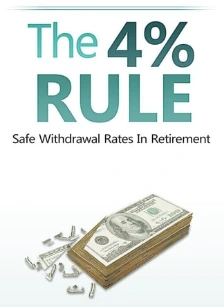Retirement is a long-awaited milestone, but it’s also a time to carefully manage your finances. Retirement withdrawal rates are a crucial aspect of planning for a comfortable and secure retirement. It’s not just about how much you save; it’s also about how you withdraw those savings to ensure they last throughout your retirement years.
What is a Retirement Withdrawal Rate?
A retirement withdrawal rate is the percentage of your retirement savings that you plan to withdraw each year. This rate is a crucial part of your overall retirement strategy, as it directly impacts how long your savings will last.
Understanding the Concept of Retirement withdrawal rates
Think of it like a faucet. If you open the faucet wide, your savings will drain quickly. Conversely, if you open the faucet just a crack, your savings will last longer. The same principle applies to retirement withdrawals. A high withdrawal rate may lead to running out of money before you need to, while a low withdrawal rate may leave you with substantial funds remaining at the end of your life.
**Related: 9 Best Growth Stocks for the Next 10 Years: A Guide For The Middle Class Investor
How Withdrawal Rates Impact Retirement Security
The withdrawal rate you choose plays a significant role in your retirement security. A higher withdrawal rate might initially provide a more comfortable lifestyle, but it increases the risk of depleting your savings prematurely. A lower withdrawal rate helps preserve your capital and extends the lifespan of your retirement funds, but it may mean a more modest lifestyle.
Factors Affecting Retirement Withdrawal Rates
Several factors can influence the appropriate withdrawal rate for your individual situation:
Savings Balance
Your savings balance is a primary driver of your retirement withdrawal rates. The larger your savings, the more you can withdraw each year while still maintaining the longevity of your retirement funds.
Investment Returns
Investment returns play a crucial role in retirement withdrawals. Higher returns allow for larger withdrawals without depleting your principal. However, relying solely on high returns can be risky, as investment markets can fluctuate.
Life Expectancy
Life expectancy is an essential factor to consider. The longer you expect to live, the lower your retirement withdrawal rates needs to be to ensure your savings last.
**Related: Impact Investing for Beginners: A Guide to Making a Difference with Your Money
Spending Needs
Your lifestyle and spending habits in retirement will dictate your withdrawal needs. If you plan to travel extensively or maintain a lavish lifestyle, you’ll need a higher withdrawal rate. However, a simpler lifestyle may allow for a lower withdrawal rate.
The 4% Rule: A Starting Point
The 4% rule is a commonly cited starting point for retirement withdrawals. This rule suggests withdrawing 4% of your savings in the first year of retirement and then adjusting that withdrawal for inflation annually.

Origins and Assumptions
The 4% rule originated from a study by William Bengen, who analyzed historical stock market data. It was based on the assumption that a retiree could withdraw 4% of their portfolio each year, adjusted for inflation, for 30 years and not run out of money.
Pros and Cons of the 4% Rule
Pros:
- Simplicity: It’s a straightforward rule that’s easy to understand and apply.
- Historical Success: The 4% rule has historically been successful in helping retirees maintain their savings.
Cons:
- Not Guaranteed: Past performance is not indicative of future results. Market conditions can change, potentially impacting the success of the 4% rule.
- One-Size-Fits-All: The 4% rule doesn’t account for individual circumstances, such as investment strategy, spending habits, or life expectancy.
Adapting the Rule
While the 4% rule is a good starting point, it’s essential to adapt it to your unique situation. Consider factors like your desired retirement lifestyle, expected investment returns, and life expectancy. You may need to adjust your withdrawal rate based on these factors.
Retirement Withdrawal Strategies
There are various approaches to withdrawing from your retirement savings, each with its advantages and disadvantages:
Fixed Percentage Withdrawal
This strategy involves withdrawing a fixed percentage of your portfolio each year, adjusted for inflation. This approach offers simplicity and predictability but can be risky if investment returns are low.
Variable Withdrawal
A variable withdrawal strategy allows you to adjust your withdrawal rate based on your investment performance and other factors. This approach can be more flexible but requires more careful monitoring and planning.
Annuitization
Annuitization involves converting a portion of your retirement savings into a guaranteed stream of income for life. This strategy provides income security but may result in lower overall returns.
Reverse Mortgages
A reverse mortgage allows homeowners aged 62 or older to borrow against their home’s equity. This can provide a supplemental income stream in retirement but can have significant drawbacks, such as increasing your debt and potentially losing your home.
Income Sources in Retirement
Retirement income isn’t just about withdrawals from savings. You may also receive income from several other sources:
Social Security Benefits
Social Security is a federal government program that provides retirement benefits to eligible individuals. It’s a vital source of income for many retirees.
Pensions
Some retirees receive pensions from their former employers. These are typically guaranteed income streams for life.
Investments
Investment income from stocks, bonds, and other assets can supplement your retirement income. However, investment returns are not guaranteed.
Part-time Work
Many retirees choose to work part-time for additional income. This can help maintain a healthy lifestyle and provide mental stimulation.
Other Sources
Other sources of retirement income may include rental income, royalties, or government assistance programs.
Inflation and Retirement Withdrawals
Inflation is a significant factor to consider when planning retirement withdrawals. As prices rise, your purchasing power decreases, and you need to withdraw more money to maintain your standard of living.
Impact of Inflation
Inflation can erode the value of your retirement savings over time. If your withdrawals don’t keep pace with inflation, you’ll need to reduce your spending or deplete your savings faster.
Inflation-Adjusted Withdrawal Rates
To account for inflation, you can adjust your withdrawal rate each year. This means increasing your withdrawal by the rate of inflation to maintain your purchasing power.
Protecting Your Savings
Investing in assets that have the potential to outpace inflation can help protect your savings. These may include stocks, real estate, or inflation-protected bonds.
Tax Implications of Retirement Withdrawals
The tax implications of retirement withdrawals vary depending on the type of account from which you’re withdrawing.
Taxable vs. Tax-Free Income
Withdrawals from traditional IRAs and 401(k)s are generally taxable as ordinary income. However, withdrawals from Roth IRAs are typically tax-free.
Tax Brackets and Withdrawal Strategies
Your tax bracket can influence your withdrawal strategy. If you’re in a lower tax bracket in retirement, you may want to withdraw more from tax-deferred accounts. Conversely, if you’re in a higher tax bracket, you may want to withdraw more from tax-free accounts.
Tax Planning
It’s essential to consider tax implications when planning your retirement withdrawals. Consulting a financial advisor or tax professional can help you develop a tax-efficient withdrawal strategy.
Retirement Withdrawal Mistakes to Avoid
Common mistakes can jeopardize your retirement income plan:
Withdrawing Too Much Too Soon
A common mistake is withdrawing too much money from your retirement savings in the early years. This can deplete your savings faster and leave you with less money for later years.
Not Accounting for Inflation
Failing to adjust your withdrawal rate for inflation can erode your purchasing power and force you to reduce your spending later in retirement.
Ignoring Tax Implications
Not considering the tax implications of your withdrawals can lead to unexpected tax bills and reduce your after-tax income.
Managing Your Retirement Income
Once you’ve developed a retirement withdrawal strategy, it’s essential to manage your income effectively:
Creating a Budget
A budget helps you track your income and expenses, ensuring you stay within your means.
Tracking Your Expenses
Monitoring your spending habits helps you identify areas where you can cut back or adjust your budget.
Adjusting Your Spending
As your income and expenses change, you may need to adjust your spending habits to stay on track.
Contingency Planning
Having a contingency plan for unexpected events, such as medical expenses or job loss, can help ensure your retirement income is protected.
Retirement Withdrawal Tools and Resources
Several tools and resources can help you plan and manage your retirement withdrawals:
Online Retirement Calculators
Online retirement calculators can help you estimate your withdrawal rate based on your savings, expenses, and life expectancy.
Financial Planners
Financial planners can provide personalized advice on retirement withdrawal strategies and help you develop a comprehensive plan.
Retirement Planning Books
Numerous books offer valuable insights into retirement planning, including strategies for managing your withdrawals.
Articles and Videos
Many online articles and videos provide information on retirement withdrawal rates, strategies, and best practices.
FAQs
- What is a good retirement withdrawal rate? There’s no one-size-fits-all answer. The 4% rule is a starting point, but your withdrawal rate should be adjusted based on your individual circumstances.
- How do I adjust my withdrawal rate for inflation? Retirement withdrawal rates- You can use an inflation calculator to determine the current inflation rate and adjust your withdrawal accordingly. For example, if the inflation rate is 3%, you would increase your withdrawal by 3% each year.
- How do I know if I’m withdrawing too much from my retirement savings? You should monitor your savings balance and projected expenses to ensure you’re not depleting your savings too quickly.
- What happens if I run out of money in retirement? If you run out of money in retirement, you may have to rely on family or government assistance. It’s essential to plan carefully and avoid unnecessary risks.
- Should I withdraw from my retirement savings before I retire? It’s generally advisable to avoid withdrawing from your retirement savings before retirement, as this can impact your overall savings balance and potentially increase your tax burden.
- How do I find a financial planner to help me with retirement planning? You can ask for recommendations from friends, family, or colleagues. You can also search online for financial planners in your area.
Conclusion
Retirement withdrawal rates are a critical aspect of planning for a comfortable and secure retirement. Choosing the right withdrawal rate is essential for ensuring your savings last throughout your retirement years. By understanding the factors that influence Retirement withdrawal rates, developing a sound withdrawal strategy, and managing your retirement income effectively, you can increase your chances of enjoying a financially secure retirement. Remember to seek guidance from financial professionals and utilize the tools and resources available to make informed decisions.



